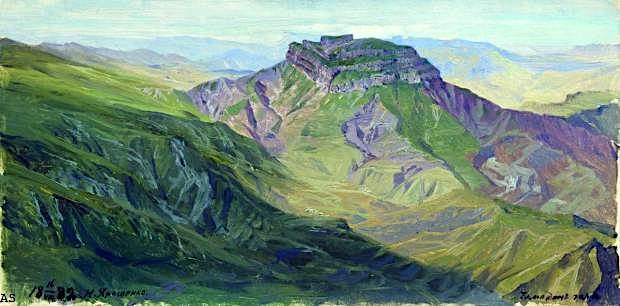Volcan d'Urup (1,426m)
Russie (Iles Kouriles)
Le volcan
Urup du japonais :得撫島 (1,426m) est une
île volcanique inhabitée de la chaîne des Iles Kouriles au sud de la mer
d'Okhotsk, nord-ouest de l'Océan Pacifique.
Urup est essentiellement
de forme rectangulaire, avec un axe long de 120 kilomètres
et un axe étroit d'environ 20 kilomètres C'est la quatrième
plus grande des îles Kouriles, avec une superficie de 1 430 kilomètres
carrés Le point culminant est Gora Ivao à 1 426
mètres. Un certain nombre de minuscules îlots et rochers
dont celui qui a été photographié ci-dessus, sont dispersés autour de la
côte d'Urup.
Le détroit entre Urup et Iturup est connu sous le nom de Détroit de Vries d'après l'explorateur néerlandais Maarten Gerritsz
Vries, le premier européen enregistré à explorer la région. Le détroit
entre Urup et Simushir est connu sous le nom de Détroit de Bussol,
d'après le mot français " boussole ", qui était le nom d'un des
navires de La Pérouse, marin français qui explora la région des îles
Kouriles en 1780.
Urup se compose de quatre grands groupes de
stratovolcans actifs ou dormants de l'île. Le cône le plus au sud-est
coupe en deux une vallée glaciaire, formant un lac. Pendant la seconde
guerre mondiale, tous les habitants civils de l'île ont été déplacés
vers les îles d'origine japonaises, et à la fin de la guerre, l'armée impériale japonaise avati stationné environ 6000 soldats sur Urup.
Lors de l' invasion des îles Kouriles par l' Union Soviétique après la
fin de la seconde guerre mondiale, les forces japonaises d'Urup se sont
rendues sans résistance. En 1952, lors de la signature du traité de San
Francisco, le Japon a renoncé à sa revendication sur l'île. Les troupes
frontalières soviétiques ont occupé les anciennes installations
militaires japonaises. Les troupes ont été retirées lors de la
dissolution de l'URSS en 1991.
Cartes postales anciennes
Les cartes postales
ont été colorisées dès leur apparition sur le marché à la fin du 19e
siècle ; les photos en noir et blanc étaient repeintes à la main par des
femmes avec des pinceaux très fins, puis un vernis était appliqué pour
fixer ces couleurs toujours très contrastées... et parfois très
éloignées de la réalité !
Les cartes postales sont devenues
populaires au tournant du 20e siècle, notamment pour envoyer de courts
messages à des amis et à des proches. Elles ont été collectionnées dès
le début et sont toujours recherchées aujourd'hui par les
collectionneurs de photographie de publicité, de souvenirs de guerre,
d'histoire locale et de bien d'autres catégories. Les cartes postales
étaient un engouement international, publiées dans le monde entier. La
Detroit Publishing Co. et Teich & Co. étaient deux des principaux
éditeurs aux États-Unis, et parfois des particuliers imprimaient
également leurs propres cartes postales. Yvon était le plus célèbre de
France. De nombreux éditeurs individuels ou anonymes ont existé dans le
monde et notamment en Afrique et en Asie (Japon, Thaïlande, Népal,
Chine, Java) entre 1920 et 1955. Ces photographes étaient pour la
plupart des notables locaux, des militaires, des guides officiels
appartenant aux armées coloniales (britanniques français, belge...) qui
disposaient parfois d'un matériel assez sophistiqué et produisaient
volontiers des photogrammes en couleur ou des explorateurs, navigateurs,
alpinistes (Vittorio Sella et l'Archiduc des Abruzzes futur roi
d'Italie reste le plus célèbre d'entre eux).
Il existe de nombreux types de cartes postales anciennes à collectionner.
Les
cartes postales résistantes à la lumière étaient fabriquées avec du
papier de soie entouré de deux morceaux de papier ordinaire, de sorte
que la lumière passait à travers. Les cartes postales dépliantes,
populaires dans les années 1950, avaient plusieurs cartes postales
attachées dans une longue bande. Les cartes postales photographiques
réelles (RPPC) sont des photographies avec un support de carte postale.
Des
cartes postales originales ont été fabriquées à partir de bois,
d'aluminium, de cuivre et de liège. Les cartes postales en soie -
souvent brodées sur une image imprimée - étaient enroulées autour de
carton et envoyées dans des enveloppes transparentes en papier cristal;
ils étaient particulièrement populaires pendant la Première Guerre
mondiale.
Dans les années 1930 et 1940, les cartes postales étaient
imprimées sur du papier aux couleurs vives conçu pour ressembler à du
lin.
________________________________________
2023 - Gravir les montagnes en peintureUn blog de Francis Rousseau

















